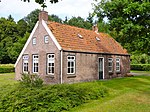The United Nations Educational, Scientific and Cultural Organization (UNESCO) World Heritage Sites are places of importance to cultural or natural heritage as described in the UNESCO World Heritage Convention, established in 1972. [1] Cultural heritage consists of monuments (such as architectural works, monumental sculptures, or inscriptions), groups of buildings, and sites (including archaeological sites). Natural features (consisting of physical and biological formations), geological and physiographical formations (including habitats of threatened species of animals and plants), and natural sites which are important from the point of view of science, conservation or natural beauty, are defined as natural heritage. [2] The Netherlands accepted the convention on 26 August 1992, making its natural and historical sites eligible for inclusion on the list. [3]
Contents
There are 13 properties in the Kingdom of the Netherlands inscribed on the World Heritage List. [4] [5] [6] Twelve of those sites are in the Netherlands (of which three are shared with neighbouring countries) and one is in Curaçao, in the Caribbean. The Netherlands and Curaçao are both constituent countries of the Kingdom of the Netherlands. Twelve sites are cultural properties and one is a natural property. [3] The first site added to the list was Schokland and Surroundings in 1995. The transnational site Wadden Sea (a natural site) is shared with Denmark and Germany, the Colonies of Benevolence are shared with Belgium, and the Lower German Limes is shared with Germany. There are currently two properties on the tentative list. One of these sites is in Curaçao, and one is in Bonaire, which is a special municipality of the Netherlands, located in the Caribbean. [3]



















